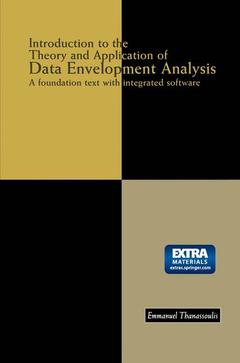Introduction to the Theory and Application of Data Envelopment Analysis, Softcover reprint of the original 1st ed. 2001 A Foundation Text with Integrated Software
Langue : Anglais
Auteur : Thanassoulis Emmanuel

1 DATA ENVELOPMENT ANALYSIS Data Envelopment Analysis (DEA) was initially developed as a method for assessing the comparative efficiencies of organisational units such as the branches of a bank, schools, hospital departments or restaurants. The key in each case is that they perform feature which makes the units comparable the same function in terms of the kinds of resource they use and the types of output they produce. For example all bank branches to be compared would typically use staff and capital assets to effect income generating activities such as advancing loans, selling financial products and carrying out banking transactions on behalf of their clients. The efficiencies assessed in this context by DEA are intended to reflect the scope for resource conservation at the unit being assessed without detriment to its outputs, or alternatively, the scope for output augmentation without additional resources. The efficiencies assessed are comparative or relative because they reflect scope for resource conservation or output augmentation at one unit relative to other comparable benchmark units rather than in some absolute sense. We resort to relative rather than absolute efficiencies because in most practical contexts we lack sufficient information to derive the superior measures of absolute efficiency. DEA was initiated by Charnes Cooper and Rhodes in 1978 in their seminal paper Chames et al. (1978). The paper operationalised and extended by means of linear programming production economics concepts of empirical efficiency put forth some twenty years earlier by Farrell (1957).
1. Introduction to Performance Measurement.- 2. Definitions of Efficiency And Related Measures.- 3. Data Envelopment Analysis Under Constant Returns to Scale: Basic principles.- 4. Data Envelopment Analysis Under Constant Returns to Scale: General Models.- 5. Using Data Envelopment Analysis in Practice.- 6. Data Envelopment Analysis Under Variable Returns to Scale.- 7. Assessing Policy Effectiveness And Productivity Change Using Dea.- 8. Incorporating Value Judgements in Dea Assessments.- 9. Extensions to Basic DEA Models.- 10. A Limited User Guide for Warwick DEA Software251.- Author Index.- Topic Index.- References.
Date de parution : 03-2013
Ouvrage de 281 p.
15.5x23.5 cm
Date de parution : 07-2001
Ouvrage de 281 p.
15.5x23.5 cm
Thèmes d’Introduction to the Theory and Application of Data... :
© 2024 LAVOISIER S.A.S.



